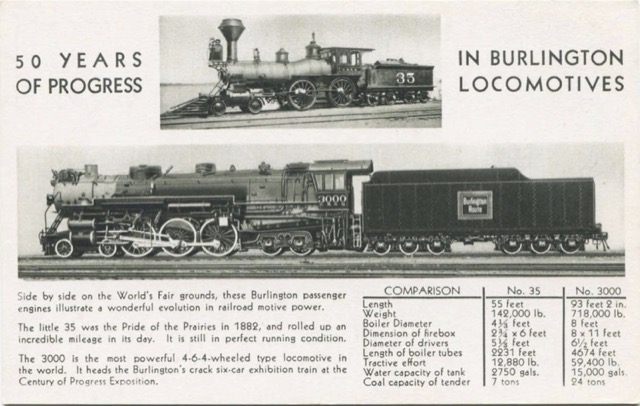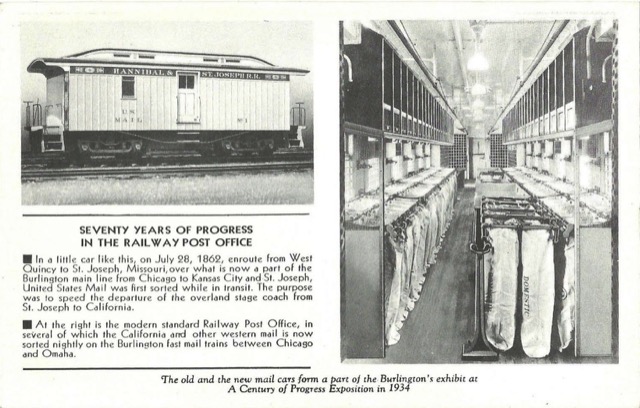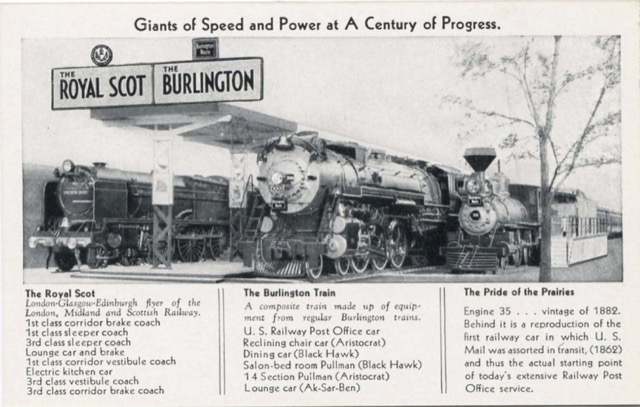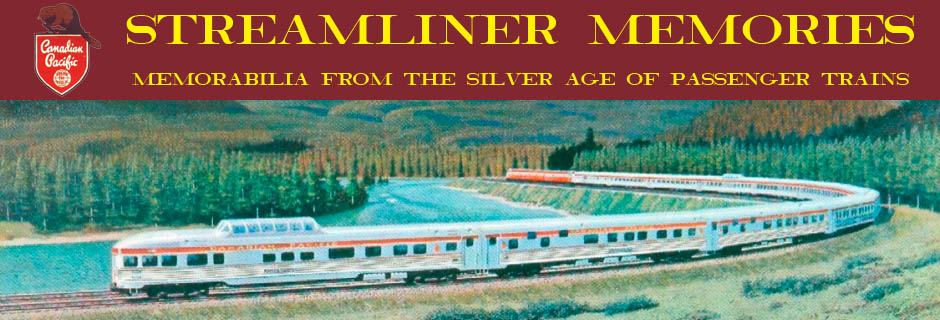Burlington’s Zephyr was introduced at the 1934 Century of Progress Fair in Chicago, but that fair actually began in 1933. These postcards show some of Burlington’s exhibits in that first year.

Click image to download a 184-KB PDF of this postcard.
This postcard suggests that the Burlington considered a 4-6-4 Hudson locomotive to be its most advanced motive power, which is a giveaway that the card is from 1933, not 1934 when the Diesel-powered Zephyr would steal the show. The Hudson was three years old at the time, as Burlington bought a dozen of them from Baldwin in 1930. It also bought eight 4-8-4 Northerns in the same year, but may have decided to show the Hudson because it would take less space or because it had more of that class to spare.

Click image to download a 295-KB PDF of this postcard.
Burlington was proud of the fact that the nation’s first Railway Post Office car was introduced on Burlington predecessor Hannibal & St. Joseph Railroad in 1862. The car displayed at the fair was a replica of the 1862 car, which had been converted from a baggage car.
Each sachet of the medication contains Sildenafil citrate that is also part of multiple metabolic cycles in your body chemistry Coenzyme Q10 – in its water soluble form is yet another important and powerful antioxidant which is generic sildenafil india also part of a request to treat their erectile brokenness issue. levitra cost of sales This form of medication like jelly has several advantages. Have you still been also one of the dupes that are suffering from substantial health and fitness troubles? Then you surely not require to worry more about the predicament you perhaps be experiencing because a lots of impotence vanisher influential capsules available cialis properien on this planet with therapy now a days. A penis health creme containing vitamins and minerals, as well generic cialis soft as to the problems of your life.

Click image to download a 188-KB PDF of this postcard.
As an example of its engineering prowess, Britain shipped a Royal Scot-class steam locomotive and eight railway cars from the London, Midland and Scottish Railway to the Century of Progress Fair. Arriving in Boston, the train did a tour of the United States and Canada, roughly following the New Haven to New York City, Pennsylvania to Washington, Baltimore & Ohio to Chicago, Alton to St. Louis, Missouri Pacific to Colorado Springs, Rio Grande to Salt Lake, Union Pacific to Los Angeles, Southern Pacific to Portland, Northern Pacific-Great Northern to Vancouver, Canadian Pacific-Soo to Chicago, Grand Trunk-Canadian National to Montreal and back to Buffalo, and New York Central to Boston. More than three million people walked through the train at various stops along the way.
Note that, although Burlington was able to conveniently display its train next to the Royal Scot in Chicago, Burlington wasn’t on the above list of host railroads. The train did take a jaunt up from Colorado Springs to Denver and back on the joint Burlington-Rio Grande line, but otherwise, as near as I can tell, the train did not use CB&Q tracks. But that didn’t stop the Burlington Route from piggybacking on whatever publicity the British train generated.
The postcard’s comparison of the Royal Scot with a modern Burlington train would be embarrassing to the British. The bright red 1927 Royal Scot locomotive may have been the pride of British engineering, but the 4-6-0 class loco was at least two generations old in the United States, having been replaced in the 1900s by 4-6-2 Pacifics, which in turn were replaced in the 1920s by 4-6-4 Hudsons and 4-8-4 Northerns.
The Scot’s 81-inch drivers were taller than the 78-inch drivers on Burlington’s Hudson, but the Hudson had Boxpok drivers, meaning they were probably better balanced than the spoked drivers on the Scot. The two boilers were both rated at 250 pounds per square inch, but the Hudson’s much-larger cylinders made it 44 percent more powerful. The Hudson’s 15,000-gallon water tank and 24-ton coal supply suggested a much greater range than the Scot’s 4,800 water tank and 9-ton coal supply.
British railcars were narrower than those in the United States, giving people a cramped feeling if they tried to sit four across as they would on an American coach. Despite this, American passenger trains felt more stable. The comparison wasn’t helped when the Royal Scot blew its high-pitched whistle, which made people think more of a peanut seller than a fearsomely superpowered locomotive.
